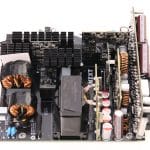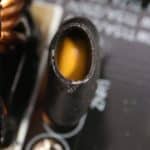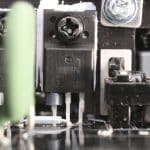Part Analysis
| General Data | |
| Manufacturer (OEM) | CWT |
| Platform | CXT |
| PCB Type | Double-Sided |
| Primary Side | |
| Transient Filter | 4x Y caps, 2x X caps, 2x CM chokes, 1x MOV |
| Inrush Protection | 1x NTC Thermistor SCK207R0 (7Ω @ 25°C) & Relay |
| Bridge Rectifier(s) |
2x WeEn WNB2560M (600V, 25A @ 127°C)
|
| APFC MOSFETs |
3x Infineon IPA60R099P6 (650V, 24A @ 100°C, Rds(on): 0.99Ohm) |
| APFC Boost Diode |
1x On Semi FFSP1665A (650V, 16A @ 135°C)
|
| Bulk Cap(s) |
2x Rubycon (420V, 680uF each or 1360uF combined, 2000h @ 105°C, MXE)
|
| Main Switchers |
2x Infineon IPA60R099P6 (650V, 24A @ 100°C, Rds(on): 0.99Ohm)
|
|
APFC Controller |
|
|
Resonant Controller |
Champion CM6901 |
| Topology |
Primary side: APFC, Half-Bridge & LLC converter
Secondary side: Synchronous Rectification & DC-DC converters |
| Secondary Side | |
| +12V MOSFETs | 10x Infineon BSC014N04LS (40V, 125A @ 100°C, Rds(on): 1.4mOhm) |
| 5V & 3.3V | DC-DC Converters: 2x QM3054M6 (30V, 61A @ 100°C, Rds(on): 4.8mOhm) & 2x QN3107M6N (30V, 74A @ 100°C, Rds(on): 2.6mOhm) PWM Controller(s): uP3861P |
| Filtering Capacitors | Electrolytic: 4x Nippon Chemi-Con (W) 3x Rubycon (4-10,000 @ 105°C, YXF) Polymer: 31x FPCAPS, 1x Nippon Chemi-Con |
| Supervisor IC | Weltrend WT7502 (OVD, UVD, PGO, ) |
| Fan Model | Hong Hua (HA13525H12SF-Z) (135mm, 12V, 0.5A Fluid Dynamic Bearing Fan) |
| 5VSB | |
| TVS Diode | P6SMB |
| Rectifier |
Pingwey R1MF
|
| Synchronous Rectification Driver |
Leadtrend LD8926AA1
|
| Standby PWM Controller | On-Bright OB2365T |
While the C1500 uses the more advanced and semi-digital CTT platform, the lower-capacity members of the same line use the analog CXT platform. The design is contemporary, with a half-bridge topology on the primary side and an LLC resonant converter. On the secondary side, a synchronous scheme rectifies the 12V rail through ten Infineon FETs, and a pair of DC-DC converters generate the minor rails.
All parts are of high quality, and the soldering quality is also good. The cooling fan is by Hong Hua, which dominates the PSU market because of its fair prices, good quality, and performance. The fan uses a fluid dynamic bearing for lower noise and increased longevity.











































Hello,
My old 550W Seasonic Focus only has one 8pin connector and I am afraid to use a Y adapter to power a 250W TDP card even with a lower power target (or is that safe?). So the way I see it, I need a new power supply and unlike the underpowered Seasonic that I bought when availability was poor in early 2020 (Chinese ports were closed due to covid), I am looking for an option that is futureproof.
However I am also motivated to not let the price get out of hand. This power supply is currently on sale for 144.90€ here in Germany at Amazon.de. At first glance, it looks like a pretty good offer. Is that power supply a good option for the money? I am intruiged by the silent operation up until 600W since I hate loud fan noises.
Thanks for your feedback.
IT is an excellent price for this PSU.
Hi Aris and many thanks for all the great reviews and articles you brought us. It really enligthen the PSU side of PC building to me !
I’m about to buy a new PSU of around 1200W, but I do hesitate betwin this C1200 from NZXT and the Super Flower Leadex VII XG 1300W.
In your opinion, wich one should I choose ? The Leadex VII looks a bit better, but is it as safe the NZXT one ? On your review of the Leadex VII XG, you don’t precise if it has a Fan Failure Protection. Do you know if it does or not ?
Also, regarding the C1200, could you please explain in wich way it is bad that 12V transient response has a deviation above 1% ? Could it cause damage to the components, or instabilities to the system, like crashes ?
About transient response, I was also wondering why you only provide those results on 115V input ? Is it because it’s less of a problem with a 230V input ? or maybe just because the results are about the same with both voltages ?
Hi! I will get the SF unit between these two. Above 1% transient response at 12V means less stability at sudden high loads. The symptoms have to do with the tolerances of the system’s parts.
Transient response is similar at 115V/230V because it is handled by the PSU’s secondary side.
Ok, great, thank you your clear advices and explanations !
I will maybe ask you another question about the SF one on its review page (so that others could also find the answer)…
How important is TVS diode on the 5VSB circuit? Most Psu Doesnt have it, only VITA GM line and Nzxt c1200 (which im aware of). Or does the MOV already took care most of the input transients?
II’ve read several posts online about faulty PSUs that either broke after a few months or had very loud coil whine. These were the ATX 3.0 versions. Were these issues fixed in the ATX 3.1 version?
not a clue but I can tell you that coil whine doesn’t have to do with the PSU only, but it is a combination of system parts AND the PSU.
Thought I would share my findings.
Firstly thank you crmaris for the good review based on this I decided to get the NZXT C1200, retiring my Corsair AX1200 (it’s now more than 10 years old). I found that I am using less power now, around 0.5Amps or 115 Watt (@ 230V) less power now, I tested playing the same game for the same period and logging with my Fluke 367FC. I did find that the inrush current is a bit higher at 5.2A, vs the 4.7A my corsair had. But overall super happy.
For my next build, I’m going for a complete white build. Luckily, this psu comes in white, but i saw in a video from Der Bauer that the cables are very loosely connected to the psu. Was this also the case for your unit?
https://youtu.be/rjcoCbJoDYc?si=Kl8iYOIIdaQoJ8Gg&t=693
Could you als do a review of the Phanteks revolt 1200?
The difference between the original C1200 and ATX 3.1 version is not just limited to the 12V-2×6 connector. The new version also has one extra PCIe connector, which is good if you have a GPU with three PCIe connectors like the 7900 XTX from AIBs.
Are there any plans to test the be quiet! Straight Power 12 80+ Platinum?
Yes, but I don’t know when I will find the time for it.